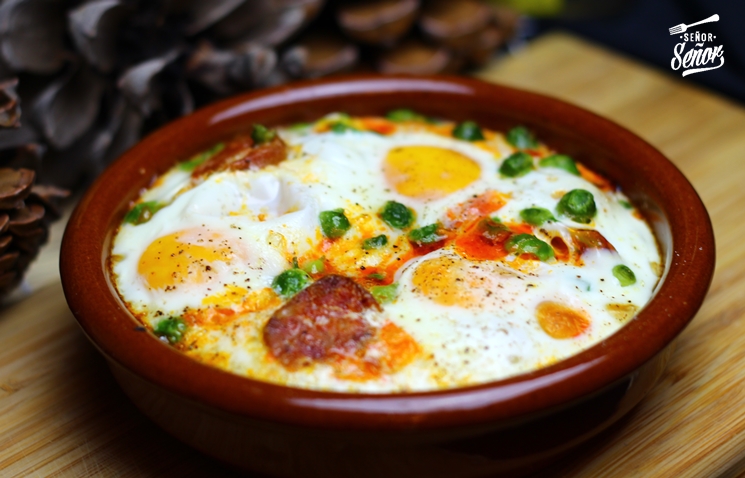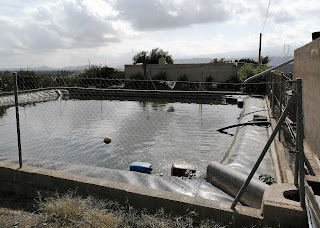There’s something queer about the food these days. You go to a restaurant to eat and half of the menu is designed for some kind of wedding feast. It’s all got cutzey for some reason. Perhaps the Michelin Man is seated at table number seven. What’s wrong with ‘sat’?
In the good ol’ days, food was food. No cream doodah then, no fennel sauces or roasted swedes. Nothing served in a ceramic spoon, for Goodness sakes! Simple stuff. A salad was lettuce, sliced onions and tomatoes with a heavy and oily aliño; now it’s got enough different kind of vegetables rattling around the plate to make a rabbit blanch. The main course used to be a plate of what one hoped were mutton chops (or were they perhaps goat?) or slices of pork, or perhaps a plate of chicken knuckles with chips.
* How to prepare chicken knuckles. Take one chicken, have at it with an axe, then drop result into a sartén with plenty of oil, peppers and garlic. Fry to taste. Riquísimo.
All the local joints could manage this simple fare, and with a bottle of gritty wine, the whole thing plus pan came to around sixty pesetas a head. Thirty cents European. Now, what’s wrong with that?
There was no menu and no price list. If you didn’t know what you wanted, or couldn’t understand the waiter, you wandered into the kitchen and pointed.
In those days, if we wanted a decent roast for home, we’d have to drive to the nearest butcher. He was a blood-spattered German trading six hours down the coast in the Calle San Miguel, Torremolinos’ famous high street. We’d fill up the plastic freezer box, spend a night or two on the tiles, and then head back up the coast with a headache the following day.
The twenty or so who made up the foreign community in the village in those days would be waiting for us on our doorstep when we returned. One of them was a retired air vice-marshal with a plummy accent called ‘Tabs’. My parents had left the door ajar one particular evening and had gone round the corner to the first and only foreign bar for a nip while the roast roasted. Tabs, on his way up the hill for a pink gin, smelt the rich smell of the roast waftin’ on the evening air and stopped by the house to invite himself to dinner. He went in and found no one around, so he checked inside the oven – as one does - to have a look at his potential dinner. Satisfied, he carried on to the pub for a large one and to obtain an invitation from my mother, in which he was successful.
Now our oven was one of those old Butano three burner ones with a lid and a slight wobble. When the hungry party returned an hour later to check on the roast’s progress my mother found that Tab’s tour of inspection had, by briefly opening the oven door, put out the gas. Tabs later recalled that ‘no one from the lower ranks had ever talked to him like that before’.
The milk in those days was undrinkable. It came in two litre glass
bottles with a thin neck. There was a slightly blue cast to it due to
the fact that the manufacturer had substituted the cream for pork grease
and added formaldehyde to keep it stable. This baby could sit in the
sun all day. Tea, if we could get it, came in teabags brought out from
England loose in people’s luggage, wrapped around the socks. Eggs and
chips were the standby at home, and cocido in the restaurant in
the square. Tabs would insist on the plates being warmed, without much
success from the kitchen-wallah, so he would usually place his plate
under his shirt for a few minutes to do the job. ‘Under trying
circumstances’, he would say, ‘one must keep up appearances’.
Another dish of the time remains to this day a favourite of mine, although it is now extremely hard to find. You see, it’s too cheap. This is ‘Huevos a la Flamenca’, a small earthen dish with ham or some kind of donkey-sausage served with peas, peppers and a fried egg. The whole, cooked in tomato paste. I happened across one the other day outside Granada: delicious!
Food, back in those days, was scarce and no one was going to mess around with sauces. Actually, come to think of it, it may have been because you couldn’t get cream. Eggs, tomatoes, potatoes, peppers, salchichón, chicken and pork was about your lot. The local grocers, known in a gesture of Spanglish relations as ‘The Foodings’ had a few tins on the shelves plus ‘Spanish’ bread, truly awful chocolate, some rather nasty looking sardines and a rack of wine in returnable bottles (two pesetas back). They’ve still got the chocolate. Credit was extended to favoured customers; a dried lima bean went into your jar for each five peseta 'duro' owed. This system was eventually overturned – literally – by an escaped chicken that broke into the store one night. Reportedly, it ate most of the evidence.
Tapas, even more than today, were the solution. One can always get a bloody good tapa in Andalucía with your quinto or your tinto. A piece of magra - lean pork - with some chips and bread. Two fried cordoñíz eggs on toast. A ham, cheese and alioli cherigan. A small plate of whitebait... a fat chunk of tortilla de guisantes... home made potato crisps (when was the last time?)... a few of those would set you up nicely.
These days, eating at a restaurant can be confusing (without worrying about wearing one's face-mask) Rather than asking 'what's on', you'll be handed a massive sticky book in several languages. The deep-freeze must be huge to store all those things on offer. If you came to talk and enjoy your meal, you'll need your glasses first. I always order what the other person's having - unless, of course, they've got Huevos a la Flamenca.
